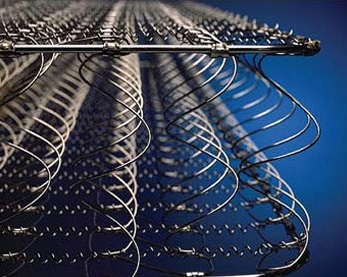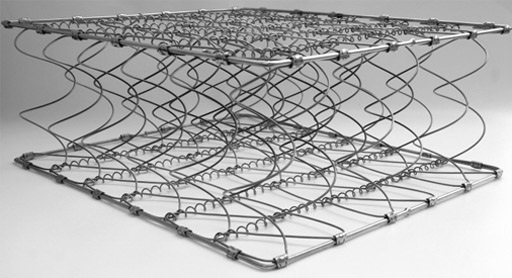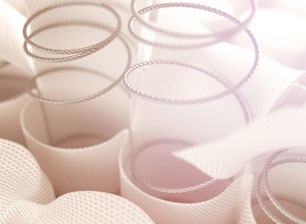The best selling mattresses over time have been innerspring mattresses. The first mattress springs were adapted from buggy seat springs. These springs are called Bonnell coils. For a long time, they were the only kind of springs used in mattresses. Now there are several types of innerspring coils. The major kinds are Bonnell, Offset, Continuous and Pocket. Within each of these kinds are variations. Each type of innerspring has its own advantages and disadvantages.
These are the oldest type of mattress innerspring coils. Adapted from buggy seat springs, they were patented by Louis Andrew Vargha in the 1800’s (1). They are shaped like an hourglass and tied together with small helical wires. Less expensive to make, they are usually found in inexpensive mattresses. They are initially very supportive, but are not very durable unless made of heavy-gauge tempered wire, especially when using special alloys. Therefore, they do not usually have a long lifetime.
One advantage which is also a disadvantage is the hourglass shape. This makes the Bonnell coil very flexible, but it a weak point which can give way and sag. This is why Bonnell coil mattresses usually have shorter warranty periods. Another disadvantage is that weight on one part of the innerspring pulls down a large area of the surface. When one sleeper moves, the other sleeper feels it. This is called “motion transfer.”
A Bonnell coil mattress may be a good low-price choice if it is well made with heavy-gauge coils, and the cost is small enough that you can replace it by the end of the warranty period.

SertaPedic SertaFlex by Serta (from their website: http://www.serta.com/buy-mattress/serta-brands/sertapedic-mattress/)
Offset coils, sometimes called Karr coils, were developed from Bonnell coils. They were invented early in the 20th Century by Frank Karr, the founder of mattress manufacturer Spring Air.
The ends of the offset coil are not circular in shape like the Bonnell, but are squared-off on opposite sides. Each squared side of an offset coil is tied to that of another coil by a short helical wire. This connection is like a hinge, allowing the surface of the innerspring to be more flexible than the Bonnell. This means less motion transfer.
Often, offset coils are described as “alternating.” The coils alternate in the direction they turn; one turns to the right, the next to the left.
Offset coils are more durable than Bonnells. The hourglass shape is less pronounced, and the wider middle is stronger. Offset coils are more likely to be found in more expensive innerspring models, both because of the higher quality and durability and because of the higher manufacturing cost.

Continuous coils

Continuous coil innerspring unit
Image from Bedrooms & More, Seattle, Washington
These are called continuous coils because a whole row of coils is made from one strand of coil wire. Therefore the top of a coil is attached to a coil on one side, and the bottom to the one on the other side. Rows of coils usually run head-to-toe to minimize motion transfer. Several manufacturers, especially Serta, have product lines featuring continuous coil innerspring units. One advantage they and some retailers cite is their durability.

Pocket Coils (from Simmons: http://www.serta.com/buy-mattress/perfect-sleeper/essentials-mattress#why-tab)
Invented and patented in 1900 by James Marshall, pocket coils are unattached individual coils, each one in a fabric pocket. The principal advantages of pocket coils are conformability and elimination of motion transfer.
Each coil responds independently to weight placed directly on it. The coils are kept in place by stitching or welding the pockets together. This allows the coil array to closely conform to the contours of a sleeper’s body. Support is evenly distributed across the body. Wider points of the body, such as hips, shoulders, knees and elbows, do not carry more than their share of the body’s weight, so this relieves pressure points, which can be painful.
Since each coil does not pull down its neighbors, Marshall coils eliminate motion transfer. When one sleeper gets into or out of bed or moves around in bed, the other sleeper is not disturbed.
A newer development is dual coils, commonly described as coil-in-coil. The key patent for dual coils is by Sealy (Larry K. DeMoss, inventor) in 2010 (9). These are pocket coils where each coil is really a double coil, one inside the other. Each coil pair is made of one piece of wire. The outer coil is taller with fewer turns and is more responsive. The shorter inner coil has more turns and is firmer. The outer coil has the initial response, giving a soft, cushioning feel. When the shorter coil is reached, the response is firmer for underlying support. This configuration allows the innerspring to adjust to sleepers of different weights.
The latest major development in steel mattress coils is microcoils. These are small pocket coils, usually 1 to 2 inches high. Microcoils are used in comfort layers, even in latex and memory foam beds. Some models have several microcoil layers. Since they are pocket coils, they are very conformable. And since they are coils with internal airflow, they are cooler than foam layers. Now there are also mini-microcoils, with heights usually less than an inch. With the variance in heights and overlapping of categories, it would be helpful if manufacturers and retailers would work together on industry standard definitions for microcoils and mini-microcoils, even adding a term for the higher ones of 2 to 4 inches.
Not all springs are made of metal. Recent developments include the introduction of wooden coils and foam springs. It would not be surprising to see the development of other non-metallic mattress springs.
Certain kinds of springs have been made from wood for thousands of years. The bow is a spring, originally formed from wood, used to propel arrows. The springs in Egyptian chariots were wood. Wooden floors fastened to joists are resilient, making walking on them easier on the feet than a concrete floor. Wooden diving boards are used as springs to catapult a diver high over the water. In beds, wood slatted frames have a resilience making them an alternative to box springs.
In 2011, Bio-Textima, a Hungarian bedding company, released their VitalWOOD mattress coils. These coils are made of European beechwood, a renewable resource. One of the goals of making these was to avoid “electromagnetic polution” or “electrosmog.” Unlike metal coils, wood coils do not collect, ocus and concentrate environmental electromagnetic radiation, whatever the original source.
While Bio-Textima was developing the techiques for making wooden mattress coils, Willy Poppe, the CEO of a Belgian bedding firm was inventing springs made of memory foam and polyurethane. Used for both comfort and support, these MemoryCoils and EcoSprings do not have the hard ends of metal coils, which are sometimes felt by sleepers.
Looking ahead, we can expect both further developments in steel mattress coils and more non-metal materials used for springs.
While considering the type of coils in a mattress, consider the gauge, coil count and arrangement of the coils as well as the type. Heavier gauge means more durability and firmer support. Higher coil count usually means more even support. Some innerspring cores have higher coil density and/or heavier coil gauge in the center part of the mattress, where most of the body weight is. When Some manufacturers say “nested coils,” they usually mean placed in a hexagonal array, which is more closely packed than a square grid, yielding a higher density.
_____________
1. Wikipedia, “Mattress” – http://en.wikipedia.org/wiki/Mattress
2. Utah State University, “Selecting an Innerspring Mattress” – http://extension.usu.edu/files/publications/factsheet/HI_08.pdf
3. Sleep Like the Dead – http://www.sleeplikethedead.com/mattress-reviews-coil.html
4. Sit’n’Sleep – https://www.sitnsleep.com/resources/article/all-about-mattress-coils
5. Bedrooms & More (Seattle) – http://www.howtoshopforamattress.com/mattress-coil-types.html
6. The Mattress Underground – http://www.themattressunderground.com/mattresses/support-cores/innersprings.html
7. Serta –
…a. http://www.serta.com/mattress-guide/getting-started/mattress-types
…b. http://www.serta.com/buy-mattress/serta-brands/sertapedic-mattress/
…c. http://www.serta.com/buy-mattress/perfect-sleeper/essentials-mattress#why-tab
…d. http://www.serta.com/buy-mattress/iseries/serta-iseries-mattress#why-tab
8. Easy Snoozing – http://www.easysnoozing.com/innerspring-mattress
9. Google, Patents, “Coil-in coil springs and innersprings: US 7908693 B2” – http://www.google.com/patents/US7908693
This entry was posted on Wednesday, February 5th, 2014 at 10:50 PM and is filed under beds, coils, innerspring, mattresses, springs . You can follow any responses to this entry through the RSS 2.0 feed. You can leave a response, or trackback from your own site.

Get New Post Notification via Email:

Awesome article mate. This is a useful article and will help people to choose a great mattress
You really cleared up a lot of things for me. I bought amazing mattresses for my bedroom, can you give me some recommendation for pillows and Shabby Chic bedding perhaps?
Very professional about mattress. I learned a lot from your website.
amazing mattresses for my bedroom, can you give me some recommendation for pillows?
Try one of the Snuggle-Pedic pillows. They are made by Selectabed, which is reviewed on Memory Foam Mattress.Org – http://memoryfoammattress.org/selectabed/. They are the top pillow in our review of the top pillows – http://www.beds.org/best_pillow_reviews.php.
beds.org is the best site of mattress reviews
really useful post. thanks for your good work.
top 10 list and best product reviews & buyer guide
Your site is with simple design and layout, but what you published are really useful. I never knew so many kinds of inner spring in one mattress. Thanks for sharing.
You really cleared up a lot of things for me. I bought amazing mattresses for my bedroom, can you give me some recommendation for pillows?